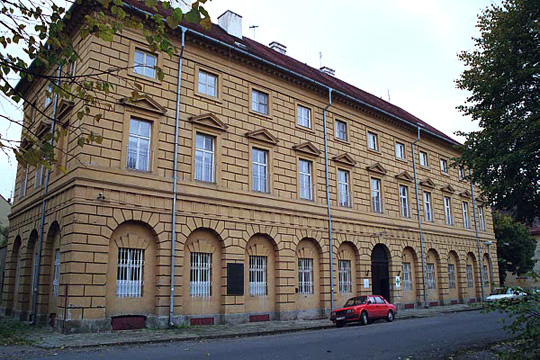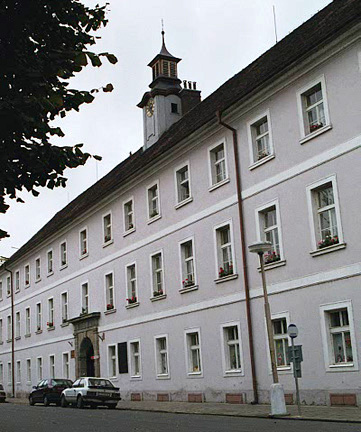Children's quarters in Theresienstadt

Building L410 was a
girls barracks and school where art lessons were taught
Theresienstadt was the designated site
for the deportation of Jewish children from the orphanages in
the Greater German Reich. Children were also sent to the ghetto
with their parents or other relatives. Approximately 10,000 children
passed through the Theresienstadt ghetto. The drawings and paintings
produced by these children in their art classes is known the
world over. Some of their artwork hangs at the US Holocaust Memorial
Museum in Washington, DC. Many other Holocaust museums display
their work also. The Jewish Museum in Prague has a collection
of 4,000 pieces of children's art from Theresienstadt.
Shown in the photo above is Building
L410, located next to the Catholic Church on Hauptstrasse, the
main street of the ghetto. This was the home for Jewish girls
from 8 to 16 years of age. The older girls, aged 14 to 16, had
to work during the day, but still took classes at night. The
building also had a basement where concert practice took place.
It was here that Mrs. Friedl Dicker-Brandejsova gave art lessons.
Under expert supervision, the children
were encouraged to express their feelings in their artwork. Some
of the drawings that have been preserved show practice sheets
where the children were obviously being taught the various elements
of drawing. The children depicted their surroundings in the ghetto
in their drawings and watercolors, but they also painted what
they remembered from their world before they were deported to
the camp.
The drawings of the children were not
censored by the Nazis, who allowed them free reign to express
themselves on paper. Remarkably, the Nazis carefully preserved
the children's artwork after the children were deported to the
death camp at Auschwitz. Of the approximately 8,000 children
who were deported out of Theresienstadt, only a fraction of them
ever returned. Their paintings, which now hang all over the world,
are a unique memorial to these innocent victims of the Holocaust.
 Post office building
which was formerly the children's nursery
Post office building
which was formerly the children's nursery
At the corner of Rathausgasse and Langestrasse,
where the bus from Prague stops, I photographed the building,
shown above, that is currently the post office in Terezin, but
in the former ghetto, it was a home for infants. It also housed
a pre-school and a kindergarten.
Some books says there were 207 babies
born in the Theresienstadt ghetto, but others say it was 275.
All adults up to age 60, and young people over the age of 14,
had to work in the Theresienstadt ghetto, so the infants and
small children were taken care of in the building shown in the
photo above, and returned to their mothers in the evening.
The building for the babies also had
space for theater performances in the evening. In addition, there
was a bakery and kitchen which supplied the meager food for the
Jews who lived in the ghetto. To the right of the post office
is the current town hall, which is barely visible in the photo
above.
Across Langestrasse, to the west of the
bus stop at the current Post Office shown in the photograph above,
is a block of buildings which were used as homes for Jewish children
in the former ghetto. Some of the buildings in this block were
also used for theater and cultural performances and building
L216 in this block was the children's library.
 Buildings which were
used as homes for children in the Theresienstadt ghetto
Buildings which were
used as homes for children in the Theresienstadt ghetto
Another building on Langestrasse, which
faces the market square on the west side of the square, is today
the Culture House of Terezin, shown in the photograph below.
There is also a bus stop in front of this building. During the
ghetto days there was a theater here where live performances
were given. It was also where the ghetto guard was housed. This
was a unit of young male inmates, organized by the Nazis to keep
order in the ghetto. Most of them were eventually sent on the
transports to the death camps, and they were later replaced by
100 men over forty who made up the new ghetto guard. In addition
to their function as killing centers, the death camps had munitions
factories where the Nazis sent young able-bodied men from the
ghetto because they needed workers for their war effort.
 Former location of
the Ghettowache (ghetto guard)
Former location of
the Ghettowache (ghetto guard)
The building next to the Ghettowache
on Langestrasse, across from the market square, is the Sapper
barracks where older Jewish prisoners were housed. The building
is shown in the photograph below. There was also an auxiliary
hospital here for patients with heart disease and tuberculosis.
There were plenty of inmates to staff this hospital, as one out
of 7 of the adult males in the ghetto was a doctor. Cultural
programs and lectures were given here as well and there was a
synagogue in the attic. Today this building is the Social Care
Home of Terezin.
 Synagogue was located
in the attic of this building
Synagogue was located
in the attic of this building
|